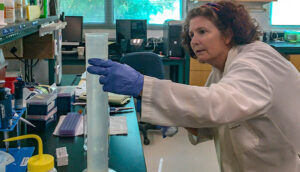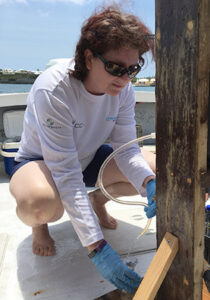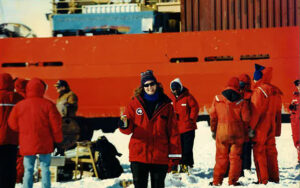Finding Success Close to Home

Rachel Parsons, a 1988 and 1989 Bermuda Program intern, currently works as the manager of the Microbial Ecology Laboratory at BIOS. Since 2016 she has been working on a five-year research project, called BIOS-SCOPE, assisting with cruise logistics, sample collection and processing, and data analysis.
For more than 40 years, the BIOS Bermuda Program has offered Bermudian students ages 18 and older the opportunity to work alongside scientists on research projects in the ocean and atmospheric sciences. During the summer, for periods of four or eight weeks, Bermuda Program interns work full time in both laboratory and field settings, gaining significant hands-on experience that often translates into advanced degrees in science, technology, engineering, and mathematics (STEM) subjects. For some students, however, their internship leads them to employment at BIOS, often as research technicians or teaching assistants.
Rachel Parsons, a Bermuda High School and Saltus senior year graduate, first heard about the Bermuda Program from her biology teacher and spent two summers during her undergraduate career (1988 and 1989) working with BIOS scientists. During that time, she began coursework at the University of Nottingham in the United Kingdom, where she graduated in 1991 with a bachelor of science in biochemistry. Parsons returned to the island after graduation and accepted a position with the Bank of Bermuda as a management trainee; however, she soon realized that she missed science and enrolled at King’s College in London where she graduated in 1993 with a master of science in aquatic resource management. She began full-time employment at BIOS in 1994 and, since then, has risen from research technician to research specialist and manager of the Microbial Ecology Laboratory.
We recently caught up with Parsons to chat about her academic and early career experiences, the role she plays at BIOS, and what her research interests are.
Tell me a little bit about what it was like growing up in Bermuda?
Bermuda was a fun place to grow up. My mother used to take us to the beach every day in the summer. I grew up catching fish, swimming, sailing, and exploring. It was a different time then and my friends and I would go off on adventures for most of the day and, as long as we were home for lunch and dinner, we were left to our own devices.
How did you become interested in science?
I was interested in nature and animals from an early age. At school, I always gravitated towards the sciences. However, it was a new chemistry teacher at Bermuda High School, Michelle Gabisi, who steered me toward my love of chemistry. She was an exceptional teacher who later became the principal at Berkeley Institute. I continued to enjoy the sciences and was further mentored by a professor at the United World College of the Atlantic.
You were a Bermuda Program student for two years. Can you share a little bit about what research projects you worked on?
I initially worked with an organic chemist who was using gas chromatography to detect oil pollution and identify its source. I also helped with sampling for the Bermuda Inshore Waters Investigation that monitored the water chemistry around Bermuda. After that, I worked with the Bermuda Atlantic Time-series Study (BATS) to measure the suite of oceanography data collected as part of that long-term program. I focused on nutrient analyses and oxygen measurements.

Parsons’ recent area of research interest concerns oxygen minimum zones and how the bacterial community changes as oxygen becomes limiting. For the last three years she has been studying Devil’s Hole, a natural “laboratory” in Harrington Sound, Bermuda, to study the effects of oxygen limitation and ocean acidification. This ongoing research involves intensive fieldwork to capture samples of both the bacterial communities and the oxygen levels in the water.
What made you return to BIOS after getting your degree?
As part of my master’s program, I had a work placement at BIOS developing a method for measuring human contamination in ocean water. After graduation, another colleague in the same master’s program helped me secure a temporary position at BIOS with Tony Michaels, where I assisted with the organization of an oceanography course at the Institute. My love of science and my dedication to my team and collaborations has made this a place I’ve wanted to stay. Over the years I’ve learned how to concentrate on research that interests me and how to say no to other projects that aren’t as professionally fulfilling.
What does your position at BIOS entail?
Currently, I’m working with Craig Carlson [University of California at Santa Barbara] and Stephen Giovannoni [Oregon State University] on a collaborative project funded by Simons Foundation International called BIOS-SCOPE, which stands for Bermuda Institute of Ocean Sciences – Simons Collaboration on Ocean Processes and Ecology. BIOS-SCOPE is a five-year multi-institutional research program for the study of microbial oceanography in the North Atlantic Ocean. I assist with cruise logistics, sample collection and processing, data analysis and independent research. It is my job to make sure that all samples get sent to the different collaborators and that the resulting data are analyzed, recorded, and distributed.
I continue to use microscopy techniques to study bacteria in the Sargasso Sea and have also used these techniques, along with DNA sequencing, to study bacteria associated with corals, sponges, and Sargassum seaweed.
My recent interest is with oxygen minimum zones, especially how the bacterial community changes as oxygen becomes limiting. I have been sampling Devil’s Hole, in Harrington Sound, since July 2016. This area becomes oxygen limited over the summer as temperatures cause the surface seawater to become warmer and lighter, while the deeper water is cooler and denser. The plankton that grow over the summer eventually die and sink to the bottom, where bacteria break down this organic matter and consume the oxygen. Then, in late September and October, the air temperature cools and this, as well as winter storms, can disrupt this stratification causing the water column to become mixed again. Devil’s Hole is an excellent natural laboratory to study the effects of oxygen limitation and ocean acidification.

Throughout her career, Parsons has had the opportunity to go to sea on a variety of research cruises. In 1997 she went on an expedition to the Ross Sea aboard the R/V Nathanial B. Palmer. During the trip, Parsons and her ship mates enjoyed some down time in the form of a barbeque on the ice.
What are the most challenging and rewarding aspects of the work you do?
Between 1994 and 1998, I was at sea for several months out of the year. Since I get seasick, I found this extremely challenging. Luckily, Craig [Carlson] has since allowed me to be based on land. I also struggle with all the administration that is required with doing science, especially involving ordering and shipping, as it means I have less time to spend in the lab. I find the research rewarding and have a natural ability to develop methods and streamline protocols. I am most satisfied when I get a new analysis working and am able to collect meaningful data sets.
Do you have any advice for young people who are interested in pursuing a career in the sciences?
Since 2000, I have mentored over 40 students with about a quarter of them being Bermudian students. In fact, I currently have four Bermudian students in my lab either as BIOS Bermuda Program interns or work experience students. My advice for young people who are interested in pursuing a career in the sciences is to keep up their mathematics, learn how to code as it is getting more and more important for data analysis, and try to get experience in the sciences and research through internships like the Bermuda Program.
